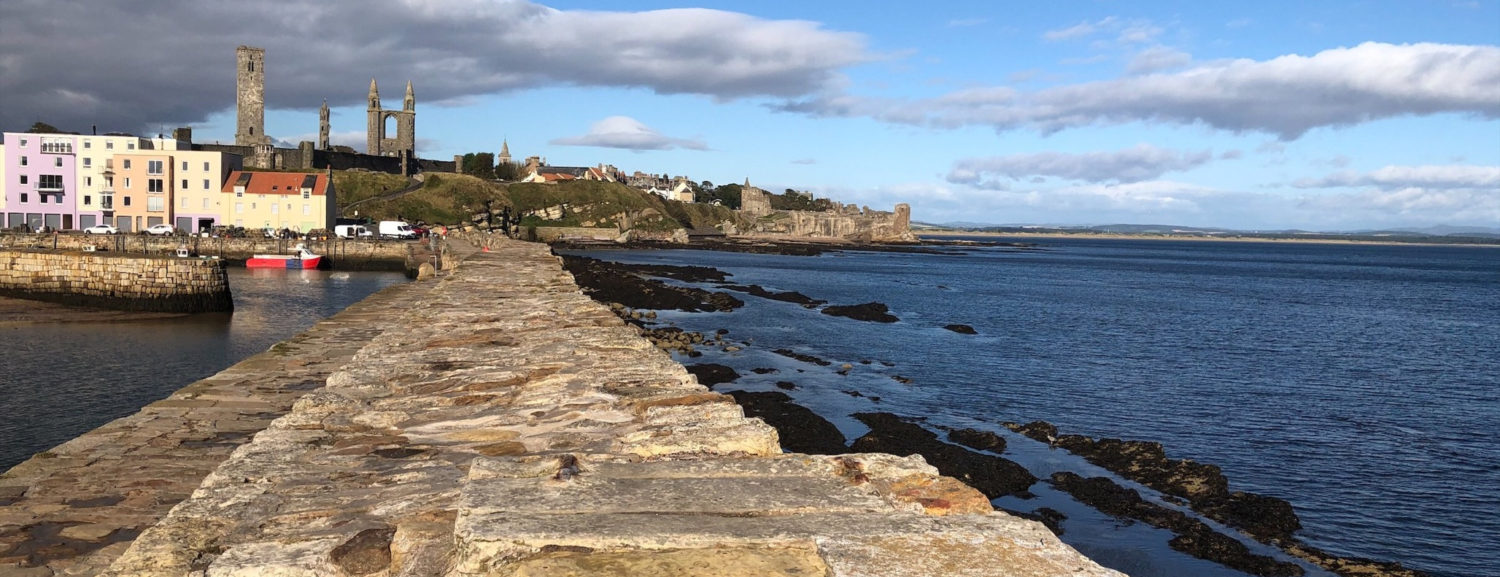ORIGINS:
Sitting at the eastern end of St Andrews’ two main streets is the imposing, if slightly confusing, collection of ruins that together make up St Andrews Cathedral and a number of associated religious buildings including St Rule’s Tower, just to the south east of the cathedral, and St Mary’s Church, just outside the precinct wall.
By 1160 it was clear that St Rule’s Church was too small to accommodate the ambitions of the Bishops, and work began on what was to become the largest cathedral ever to be built in Scotland. The work took nearly 150 years to complete. It was eventually consecrated on 5 July 1318 in the presence of Robert the Bruce.
The cathedral was not blessed by favourable elements or good luck, either during its construction or after its completion. Shortly after the nave was finished, the west end of the cathedral was blown down in a gale in 1270. This was rebuilt in a slightly different position, where parts of it remain today. Then the English stripped the lead from the part-built roofs during the Wars of Independence. In 1378 the cathedral was badly damaged by fire and had to be extensively rebuilt. And in 1409 it was the turn of the end of the south transept to collapse under the force of a winter storm.
MIDDLE AGES AND REFORMATION:
Amongst notable Ecclesiastics associated with the cathedral in the middle ages was Bishop James Kennedy, who also founded St Salvator’s College at the University of St Andrews.
The wind of change wrought by the Reformation brought about the end of the cathedral. On 11 June 1559 John Knox preached a sermon in St Andrews parish church that so aroused the congregation they immediately went to the cathedral and destroyed the splendid fittings and furnishings associated by the reformers with “popery” (see our Historical Timeline). The end followed quickly. The Church of St Mary on the Rock was probably completely destroyed shortly after it was first attacked. The cathedral and its friary effectively ceased to function on 14 June 1559 when further attacks took place, and within a week all the friars has been “violently expelled” from St Andrews.
Over the following decades there continued to be debate about restoring this, the greatest of Scottish cathedrals, but by the late 1600s the cathedral’s main role was as a quarry providing much of the building material for the subsequent development of St Andrews.
TODAY:
Today, what remains is rather fragmentary. A fair part of the magnificent precinct wall surrounding the cathedral can still be seen. Within it, you will find a portion of the west end of the cathedral, facing St Andrews, plus one nave wall, looking rather bleak, and the east gable.
To the south of the main cathedral, visitors can still wander around part of the cloister or examine the graves unearthed under the floor of the chapter house. There is also an excellent visitor centre in the undercroft of the refectory, on the south side of the cloister. This gives access to the superb St Andrews Cathedral Museum, which has an outstanding collection of carved stonework on view dating from the Pictish era until after the Reformation.
Much of the remainder of the precinct is now given over to the graveyard, and for those who find fascination in wandering around such places, this is an especially interesting one: though the best and oldest gravestones are now protected from the elements in the museum. Of particular interest given St Andrews’ golfing connections is the grave of Young Tom Morris, the golfer.
https://en.wikipedia.org/wiki/St_Andrews_Cathedral
https://mathshistory.st-andrews.ac.uk/Biographies/Scott_Lang/
https://mathshistory.st-andrews.ac.uk/Biographies/Haldane/
https://www.undiscoveredscotland.co.uk/standrews/cathedral/index.html
A Brief History of St Andrews Cathedral, Scotland:
https://theculturetrip.com/europe/united-kingdom/scotland/articles/a-brief-history-of-st-andrews-cathedral-scotland
